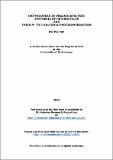Isothioureas in organocatalysis : synthesis of heterocycles and their N- to C-sulfonyl photoisomerisation
Abstract
Chapter 1 describes an introduction to the area of organocatalysis and delineates previous work within the Smith group on the use of isothioureas in asymmetric catalysis. Chapter 2 showcases a one-pot isothiourea-catalysed Michael addition-lactamisation using cheap and readily available starting materials (carboxylic acids) and easily prepared α,β-unsaturated ketimines via an ammonium enolate intermediate to give dihydropyridinones with high diastereo- and enantioselectivity (typically >90:10 dr, up to 99% ee). The resultant dihydropyridinones can be successfully derivatised into multiple products without erosion of stereointegrity. In chapter 3 the same concept has also been applied to the synthesis of planar molecules by using (phenylthio)acetic acid as a suiTable ammonium enolate precursor. Generation of an ammonium enolate using an achiral isothiourea (DHPB) and reaction with α,β-unsaturated trifluoromethyl ketones allows an isothiourea-mediated Michael addition / lactonisation / thiophenol elimination cascade reaction for the formation of 4,6-disubstituted and 3,4,6-trisubstituted 2-pyrones in good to excellent yields (61-99%). Notably this method allows low catalyst loadings of 1% to be used. The methodology has successfully been applied to the synthesis of a COX-2 inhibitor and a wide range of derivatisations has been performed, giving valuable aromatic and heteroaromatic products containing the trifluoromethyl motif. In chapter 4 a novel N- to C-sulfonyl migration of dihydropyridinones via photoisomerisation is investigated. The scope and limitations of this process is investigated and the process is shown to proceed without compromising the diastereo- or enantiomeric purity of the starting material, giving 5-sulfonyl products in good to excellent yields (67-95%). Mechanistic crossover has indicated that this migration includes an intermolecular step, while EPR studies provided evidence of its radical nature.
Type
Thesis, PhD Doctor of Philosophy
Collections
Items in the St Andrews Research Repository are protected by copyright, with all rights reserved, unless otherwise indicated.

